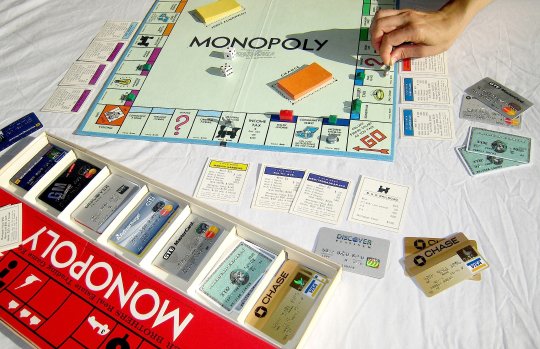Makin’ Paper Beads
August 7, 2009 at 10:37 am | Posted in Recycling | 3 Comments I’ve spent much of this morning making paper beads, which I’ve never done before. Apparently, thrifty and crafty Victorian females made beads with scrap paper, which they then strung to make bead curtains as a cheap way to divide rooms and screen areas for privacy. Instructables has a handy how-to, created by the folks at Mzuri Beads, a company in Uganda that sells cool beads (as seen at left) made from recycled paper.
I’ve spent much of this morning making paper beads, which I’ve never done before. Apparently, thrifty and crafty Victorian females made beads with scrap paper, which they then strung to make bead curtains as a cheap way to divide rooms and screen areas for privacy. Instructables has a handy how-to, created by the folks at Mzuri Beads, a company in Uganda that sells cool beads (as seen at left) made from recycled paper.
I’m experimenting with this because tomorrow I am helping to throw a baby shower, and I was sitting here trying to come up with a participatory craft/ritual/activity in which all the party guests can participate. The guest of honor loves handmade items, and she’s into nature and spirituality, but not into any specific religion, so I wondered: What can we all make that would let us put our wishes into it for her and for her partner and their baby? Maybe we could each write our private heartfelt wishes on slips of paper, then do … something … with the slips to create … something … beautiful and lasting. But what? And how to do it so that the messages remain private, so that they stay kind of secret? Hmm. By rolling them up! But … what can you make with tightly rolled slips of paper? Beads!! But … how to make them? Hmm. It’s on the Net!
So I had to practice, because tomorrow at the party I’m going to put out a tray containing glue stick, skewers, pencils, and a bunch of very long slim isosceles triangles, snipped from colorful magazine pages. Each guest can write a wish on one side of a triangle, which becomes the inside; glue stick is spread over the wish, and the triangle is rolled tightly, wide side first and message side in, around the skewer. When dry, the beads are removed, varnished, and strung. Obviously — because varnish and parties don’t go well together — I’ll have to take the beads home with me and then varnish and string them here, sending or giving the finished necklace to our guest of honor later. But she can keep it forever … and it will be full of good wishes!
In the process of practicing, I learned that two centimeters is a good width for handmade paper beads. I’m not into the metric system; it just came out that way. And I learned that “busy” magazine pages with lots of colors and patterns — and no white space — create the effects I like best. Others might prefer subtler colors, less contrast, and/or a repeating overall pattern such as flowers, dots or checks.
Tomorrow’s the party! I’ll let you know how our experiment works out.
Ten Practical Uses for Your Credit Cards
June 2, 2009 at 9:44 am | Posted in Pop culture, Recycling, Tips | 73 CommentsStop using your credit cards. They’ll just get you into debt.
But wait: Don’t throw them away. Just stop using them as they were designed to be used — that is, to pay for stuff. Save the actual cards. Because they’re useful in all sorts of ways you might never have considered.
Here are ten ways we’ve repurposed our unwanted credit cards. But the possibilities are infinite. How would you use yours? Post ideas and links in the comments section below, or email pictures of your handiwork here.
(Click each photo below to see the full-size image. Card numbers are blurred; you can never be too careful these days.)
Ten Practical Uses for Your Credit Cards
Snow goggles
 (Also formerly known as “Eskimo sunglasses.”)
(Also formerly known as “Eskimo sunglasses.”)
Burglary tool
 The original alternate use for credit cards.
The original alternate use for credit cards.
Golf putter
 Make sure to have the back of the card facing outwards; otherwise, the protruding card numbers will make it hard to aim! (This really works — click here to see a video of the credit-card putter in action.)
Make sure to have the back of the card facing outwards; otherwise, the protruding card numbers will make it hard to aim! (This really works — click here to see a video of the credit-card putter in action.)
Coinage
 If the economy collapses, we’ll have to use something for money.
If the economy collapses, we’ll have to use something for money.
Credicopter
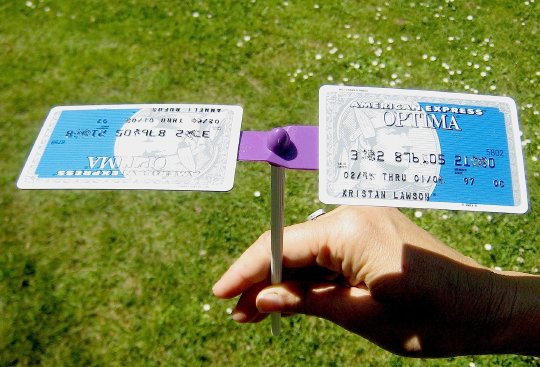 A hand-held mini-helicopter augmented with credit cards for extra lift. Click here to see the credicopter actually flying!
A hand-held mini-helicopter augmented with credit cards for extra lift. Click here to see the credicopter actually flying!
Cocaine cutter
 The other original alternate use for credit cards.
The other original alternate use for credit cards.
(Note to law enforcement: Baking powder. Not actual cocaine.)
How to Make a Credit-Card Bracelet
May 14, 2009 at 2:49 pm | Posted in Recycling, Tips | 104 CommentsEveryone knows that credit cards are for buying stuff you can’t afford. You get the stuff now, but don’t have to pay until, uh, later. Credit cards are based on the obsolete premise that in the future you’ll have more money than you have today. In the current economy, using credit cards to rack up high-interest debt is the world’s dumbest idea. The time has come to throw that credit card away —
Or to give it a whole new life as something else. Instead of using your credit card to buy a bracelet, why not turn the card into the bracelet? Pretty much useless for their original intended purpose, credit cards are like the vanished currency of a long-lost civilization. And just as humans have always adorned themselves with shiny accessories made of old coins, the time has come to do the same with credit cards. More lustrous than real gold, durable yet permeable, “gold cards,” “platinum cards” and American Express cards in particular make glorious jewelry. Repurpose these relics into tomorrow’s gems.
MAKE YOUR CREDIT-CARD BRACELET
A step-by-step photo guide
Before you get started, you will of course need to salvage an old credit card that you’ve discarded — or a new credit card that you’re about to stop using!
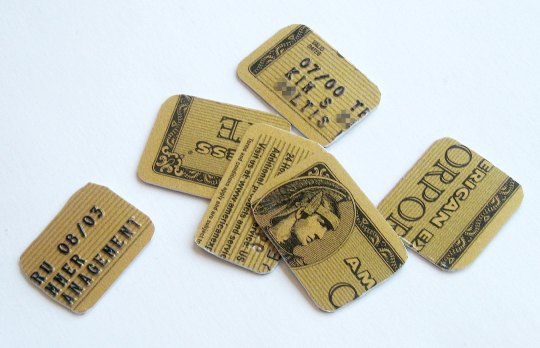
1. Cut the card into your chosen shapes: squares, rectangles, and ovals work best. Try to get at least six pieces out of each card.
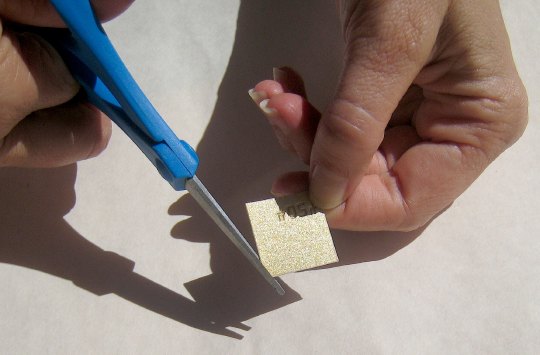
2. If you’ve chosen squares or rectangles, trim their corners to form curves. (A bracelet that jabs you or catches on things is not a fun bracelet.) Arrange the pieces in an order that pleases you.
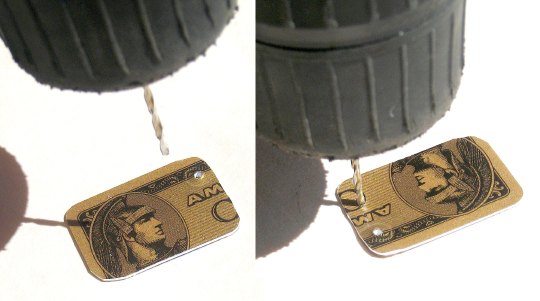
3. Using an electric drill, make holes in each card-piece through which loops will be inserted. Ensure that these holes are close enough to the edges of the plastic to accommodate at least half the diameter of each loop. Also ensure that the holes are big enough to allow the loops smooth movement. (Lacking a drill, you can make holes in the pieces using a hammer and a small nail, but the impact will create unwieldy raised edges around the holes on the reverse side.) Interior pieces need two holes at each end (equalling four holes per piece); the terminating pieces need two holes on one edge and one central hole on the final outer edge (equalling three holes each) for affixing the clasp mechanism.
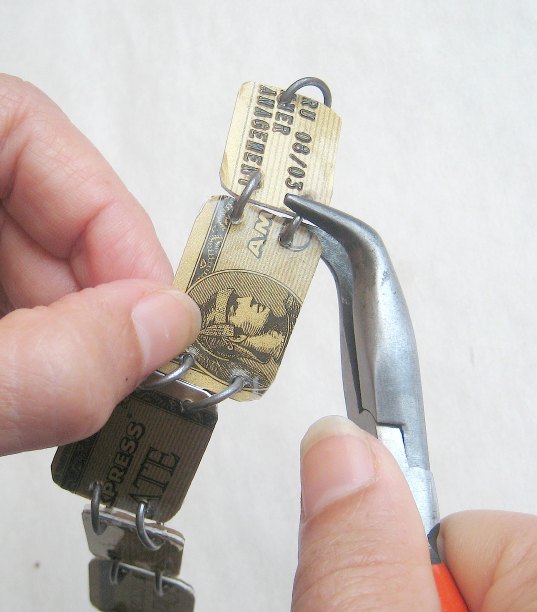
4. Insert loops through holes to connect all the pieces. Squeeze the loops tight so that they won’t slip off. Affix clasp mechanism of your choice.
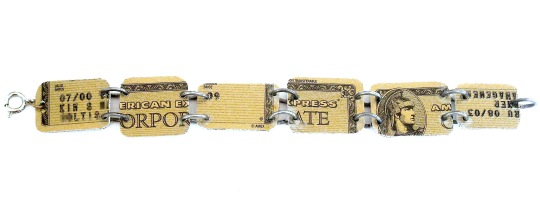
Voila! The final product.
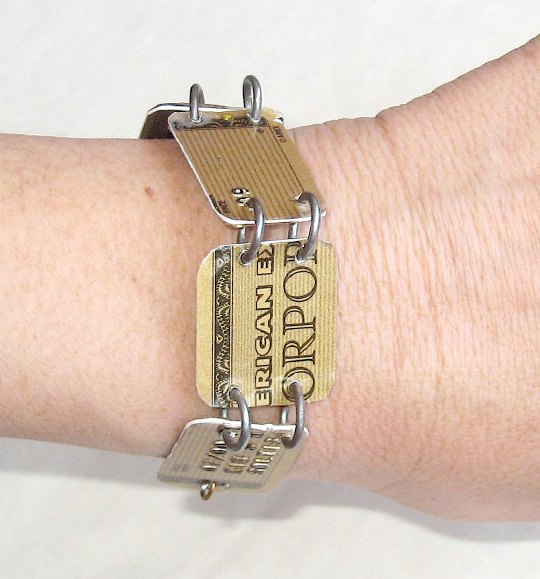
5. Enjoy your finished credit-card bracelet.
Other types of jewelry can also be made with credit cards.
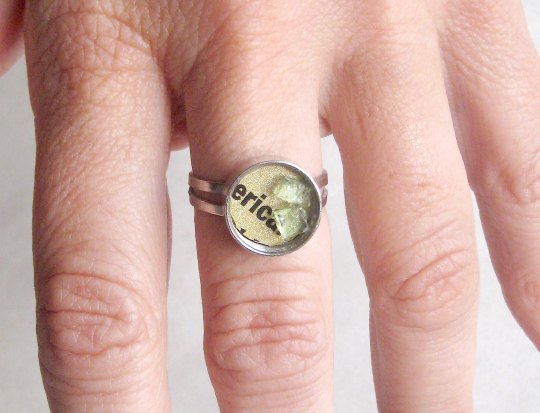
The credit-card ring — with windshield-glass “gems” scavenged from the scene of an auto burglary.

Credit-card earrings. Use your imagination to find ways of incorporating cards into other jewelry (or jewelry parts) that you’ve scavenged.
New Lives for Old Stuff
April 28, 2009 at 1:53 pm | Posted in Recycling | 1 Comment We’ve all been there: stuck with stuff we’ve scavenged but don’t know what to do with, or stuff we’ve had around the house for a while but don’t use anymore and thus don’t know what to do with, or broken stuff that we … well, don’t know what to do with, but don’t want to throw out.
We’ve all been there: stuck with stuff we’ve scavenged but don’t know what to do with, or stuff we’ve had around the house for a while but don’t use anymore and thus don’t know what to do with, or broken stuff that we … well, don’t know what to do with, but don’t want to throw out.
Find answers galore at RecycleThis, a delightful UK-based blog that is a virtual font of ideas. Repurpose nylon guitar strings into cat toys, buttons into coasters, binders into handbags…. The stream of ideas NEVER runs out, and spurs you to come up with some of your own.
Now, as for what to do with all these old cassette tapes….
Found-Art Sculptor Gives Old Saws New Life
February 25, 2009 at 7:34 pm | Posted in News, Pop culture, Recycling | 2 Comments Check out the robotic, kinetic, found-art sculptures of Nemo Gould! This clever Midwesterner-turned-Californian — whose work has been exhibited at many galleries and the San Jose Museum of Art, the Berkeley Art Museum and the Arizona Museum for Youth — uses salvaged metal, wood and more to make sleek, witty, irresistible pieces that flash, glow and gyrate. Among the elements of his 2008 work “Housecat,” you can spot a saw handle and part of a walking cane. “Octovarius” includes a salvaged violin. “Little Big Man” includes deer antlers and what looks like the casing from a vintage radio. Get a gander of ’em here. Gould himself has this to say:
Check out the robotic, kinetic, found-art sculptures of Nemo Gould! This clever Midwesterner-turned-Californian — whose work has been exhibited at many galleries and the San Jose Museum of Art, the Berkeley Art Museum and the Arizona Museum for Youth — uses salvaged metal, wood and more to make sleek, witty, irresistible pieces that flash, glow and gyrate. Among the elements of his 2008 work “Housecat,” you can spot a saw handle and part of a walking cane. “Octovarius” includes a salvaged violin. “Little Big Man” includes deer antlers and what looks like the casing from a vintage radio. Get a gander of ’em here. Gould himself has this to say:
“What makes a thing fascinating is to not completely know it. It is this gap in our understanding that the imagination uses as its canvass. Salvaged material is an ideal medium to make use of this principle. A “found object” is just a familiar thing seen as though for the first time. By maintaining this unbiased view of the objects I collect, I am able to create forms and figures that fascinate and surprise. These sculptures are both familiar and new. Incorporating consumer detritus with my own symbology, they are the synthesis of our manufactured landscape and our tentative place within it– strong and frail at the same time.”
Welcome to the Scavenging Blog!
July 13, 2007 at 1:37 am | Posted in Adventures, Book excerpts, Celebrities, Deals, Finds, News, Philosophy, Pop culture, Recycling, Reviews, Tips, Uncategorized, Videos | 1 CommentAre you a scavenger? We are. And we think there’s a lot more of us out there than anybody realizes.
Scavenging is the first and only blog devoted exclusively to the concept of the scavenger. And we’ll also explore the philosophy of scavenging as a lifestyle (or a hobby), and the critical role it plays in the world at large.
So send us your tales of scavenging, your greatest triumphs and most bitter regrets. And start thinking of yourself as a scavenger first, above all else.
Blog at WordPress.com.
Entries and comments feeds.
